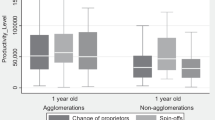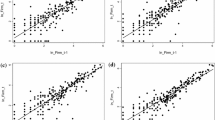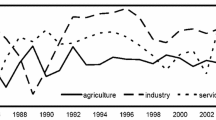Abstract
This paper empirically estimates the effect of several sources of agglomeration on new firm survival while controlling for firm, entrepreneur, and regional variables using a discrete-time hazard model. We utilize the longitudinal Kauffman Firm Survey of almost 5000 US startups from 2004 to 2011. Unlike previous studies, we find that the overall hazard of entrepreneurs shutting down their new firms is not significantly affected by regional agglomeration factors, but instead firm and entrepreneur variables. However, we find suggestive evidence that location does matter for particular groups of entrepreneurs such as high-tech startups and those firms not based out of their homes.
Similar content being viewed by others
Notes
We did estimate a cloglog specification, which is equivalent to a proportional hazard specification, and a multinomial logit model with little change in economic and statistical significance. However, the proportional hazard assumption of the cloglog model is inappropriate for entrepreneurial firm data as explained by Falck (2007) and we choose to report the logit model results.
We estimated a random effects panel logit model, but accounting for the survey weights and stratification of the KFS was not possible. However, the results of the random effects model without survey adjustment are very similar, in terms of statistical and economic significance, to the estimates we report for the survey-adjusted logit.
References
Abel, J., and R. Deitz. 2011. Do colleges and universities increase their region’s human capital? Journal of Economic Geography 12(3): 667–691.
Acs, Z., C. Armington, and T. Zhang. 2007. The determinants of new-firm survival across regional economies: The role of human capital stock and knowledge spillover. Papers in Regional Science 86(3): 367–391.
Acs, Z., D. Audretsch, and M. Feldman. 1994. Research and development spillovers and recipient firm size. Review of Economics and Statistics 76(2): 336–340.
Allison, P. 1982. Discrete-time methods for the analysis of event histories. Sociological Methodology 13: 61–98.
Allison, P. 1984. Event history analysis. Thousand Oaks: Sage Publications.
Archer, K., S. Lemeshow, and D. Hosmer. 2007. Goodness-of-fit tests for loistic regression models when data are collected using a complex sampling design. Computational Statistics and Data Analytics 51: 4450–4464.
Audretsch, D. 1991. New firm survival and the technological regime. The Review of Economics and Statistics 60: 441–450.
Audretsch, D.B., and M.P. Feldman. 1996. R&D spillovers and the geography of innovation and production. The American Economic Review 86(3): 630–640.
Ballou, J., T. Barton, D. DesRoches, F. Potter, E. Reedy, S. Shane, and Z. Zhao. 2008. Kauffman firm survey: Results from the baseline and first follow-up surveys. Kansas City: Kauffman Foundation.
Becker, E. 1973. The Denial of Death. New York: Free Press.
Brockmann, E., and O. Simmonds. 1997. Strategic decision making: The influence of ceo experience and use of tacit knowledge. Journal of Managerial Issues 9(4): 454–68.
Burger, M., F. Van Oort, and O. Raspe. 2011. Agglomeration and new establishment survival: A mixed hierarchical and cross-classified model. In Entrepreneurship and regional dynamics: Drivers of innovation, ed. K. Kourtit, P. Nijkamp, and R.R. Stough, 45–63. Berlin: Springer.
Carlino, G., S. Chatterjee, and R. Hunt. 2007. Urban density and the rate of invention. Journal of Urban Economics 61: 389–419.
Carlsson, G., and K. Karlsson. 1970. Age, cohorts, and the generation of generations. American Sociological Review 35(4): 710–18.
Chinitz, B. 1961. Contrasts in agglomeration: New York and Pittsburgh. American Economic Review 51(2): 279–89.
Dahl, M., and S. Klepper. 2007. Who do new firms hire?. Working Paper.
Delgado, M., M. Porter, and S. Stern. 2010. Clusters and entrepreneurship. Journal of Economic Geography 10(4): 495–518.
Duranton, G., and D. Puga. 2001. Nursery cities: Urban diversity, process innovation, and the life cycle of products. American Economic Review 91(5): 1454–1477.
Ebert, T., T. Brenner, and U. Brixy. 2019. New firm survival: The interdependence between regional externalities and innovativeness. Small Business Economics 53: 287–309.
Fairlie, R., and A. Robb. 2008. Gender differences in business performance: Evidence from the characteristics of business owners survey. IZA Discussion Paper No. 3718.
Falck, 2007. Survival chances of new businesses: Do regional conditions matter. Applied Economics 39(16): 2039–2048.
Fischer, E., A. Reuber, and L. Dyke. 1993. A theoretical overview and extension of research on sex, gender, and entrepreneurship. Journal of Business Venturing 9: 151–68.
Fritsch, M. 2010. Start-ups in innovative industries: Causes and effects. In Handbook of innovation and entrepreneurship, ed. D. Audretsch, O. Falck, and S. Heblich. Cheltenham: Elgar.
Fritsch, M., U. Brixy, and O. Falck. 2006. The effect of industry, region, and time on new business survival: A multi-dimensional analysis. Review of Industrial Organization 28: 285–306.
Fritsch, M., and P. Mueller. 2004. The effects of new business formation on regional development over time. Regional Studies 38: 961–75.
Geroski, P. 1995. What do we know about entry? International Journal of Industrial Organization 13: 421–40.
Geroski, P., J. Mata, and P. Portugal, 2007. Founding conditions and the survival of new firms. DRUID Working Paper, No. 07-11.
Glaeser, E., H. Kallal, J. Scheinkman, and A. Shleifer. 1992. Growth in cities. Journal of Political Economy 100(6): 1126–52.
Glaeser, E., and W. Kerr. 2009. Local industrial conditions and entrepreneurship: How much of the spatial distribution can we explain? Journal of Economics and Management Strategy 18(3): 623–63.
Hecker, D. 2005. High-technology employment: A naics-based update. New York: BLS Publication.
Helsley, R., and W. Strange. 1990. Matching and agglomeration economics in a system of cities. Regional Science and Urban Economics 20: 189–212.
Hofstede, G. 2001. Culture and Organizations. London: Harper Collins.
Jacobs, J. 1970. The Economy of Cities. New York: Vintage.
Jaffe, A., M. Trajtenberg, and M. Fogarty. 2000. Knowledge spillovers and patent citations: Evidence from a survey of inventors. American Economic Review 90: 215–218.
Kalbfleisch, J., and R. Prentice. 1980. The statistical analysis of failure time data. New York: Wiley.
Kalleberg, A., and K. Leicht. 1991. Gender and organizational performance: Determinants of small business survival and success. Academy of Management Journal 34(1): 136–61.
Kolko, J. 2007. Agglomeration and co-agglomeration of services industries. Working Paper.
Krugman, P. 1991. Geography and Trade. Cambridge, MA: MIT Press.
Landier, A. 2003. Start-up financing: From banks to venture capital. Working Paper.
Landier, A. 2004. Entrepreneurship and the stigma of failure. Working Paper.
Loscocco, K., J. Robinson, R. Hall, and J. Allen. 1991. Gender and small business success: An inquiry into women’s relative disadvantage. Social Forces 70(1): 65–85.
Marshall, A. 1890. Principles of Economics. Reprinted 1997 Prometheus Books.
Muller, E., and A. Zenker. 2001. Business services as actors of knowledge transformation: The role of kibs in regional and national innovtion systems. Research Policy 30(9): 1501–1516.
Neffke, F., M. Henning, and R. Boschma. 2012. The impact of agin and technological relatedness on agglomeration externalities: A survival analysis. Journal of Economic Geography 12: 485–517.
OECD. 2005. Handbook on economic globalisation indicators. Paris: OECD.
Porter, M. 1990. The competitive advantage of nations. New York: The Free Press.
Porter, M. 1998. Clusters and the new economics of competition. Harvard Business Review 76(6): 77–90.
Porter, M. 2003. The economic performance of regions. Regional Studies 37: 549–578.
Renski, H. 2015. Externalities or experience? Localization economies and start-up business survival. Growth and Change 46(3): 458–480.
Reynolds, P., D. Storey, and P. Westhead. 1994. Cross-national comparisons of the variation in new firm formation rates. Regional Studies 28: 443–456.
Robb, A., and E. Reedy. 2012. An overview of the Kauffman firm survey. results from 2010 business activities. Available at SSRN: http://ssrn.com/abstract=2055265.
Robb, A., and J. Watson. 2012. Gender differences in firm performance: Evidence from new ventures in the united states. Journal of Business Venturing 27: 544–588.
Rosenthal, S., and W. Strange. 2003. Geography, industrial organization, and agglomeration. Review of Economics and Statistics 85(2): 377–393.
Saboe, M., and S. Condliffe. 2015. The influence of local social and industrial characteristics on emergent entrepreneurship. Review of Regional Studies 45: 203–220.
Saxenian, A. 1994. Regional advantage: Culture and competition in silicon valley and route 128. Cambridge: Harvard University Press.
Tavassoli, S. 2016. Survival of entrepreneurial firms: The role of agglomeration externalities. Entrepreneurship and Regional Development 28: 746–767.
van Stel, A., R. Thurik, S. Wennekers, and M. Carree. 2010. The relationship between entrepreneurship and economic development: Is it u-shaped?. EIM Business and Policy Research. H200824.
Wennberg, K., and G. Lindqvist. 2010. The effect of clusters on the survival and performance of new firms. Small Business Economics 34(3): 221–241.
Author information
Authors and Affiliations
Corresponding author
Additional information
Publisher's Note
Springer Nature remains neutral with regard to jurisdictional claims in published maps and institutional affiliations.
Disclaimer: Certain data included herein are derived from the Kauffman Firm Survey restricted-access data file. Any opinions, findings, and conclusions or recommendations expressed in this material are those of the authors and do not necessarily reflect the views of the Ewing Marion Kauffman Foundation.
Rights and permissions
About this article
Cite this article
Saboe, M., Condliffe, S. Explaining New Firm Survival: Is the Firm, Owner, or Agglomeration at Fault?. Eastern Econ J 46, 323–343 (2020). https://doi.org/10.1057/s41302-019-00162-3
Published:
Issue Date:
DOI: https://doi.org/10.1057/s41302-019-00162-3




